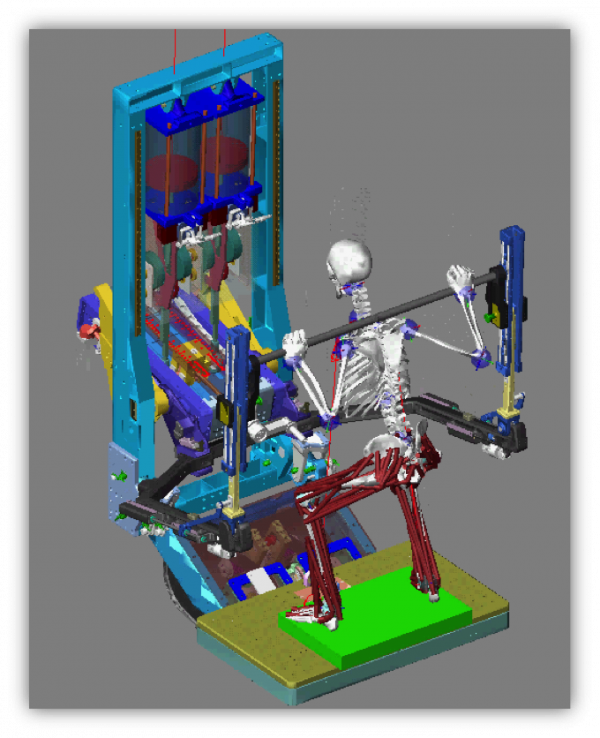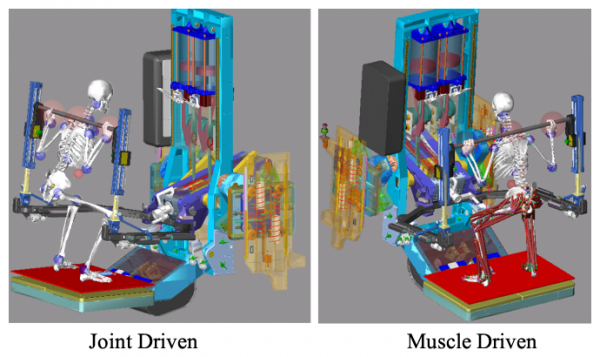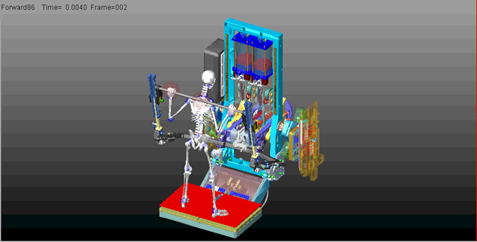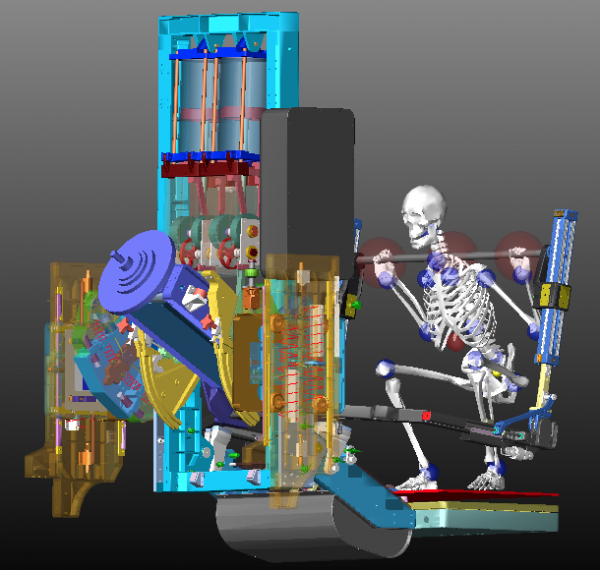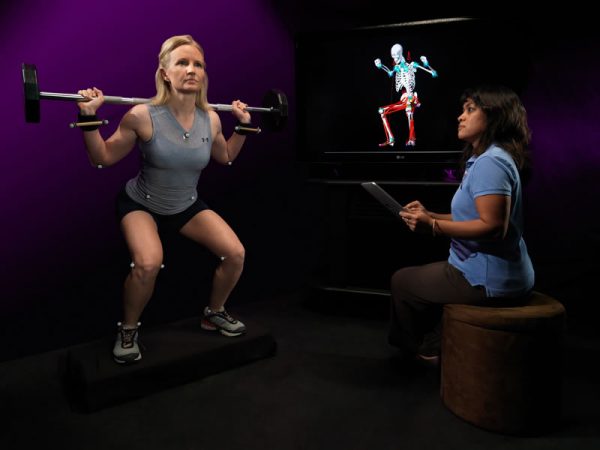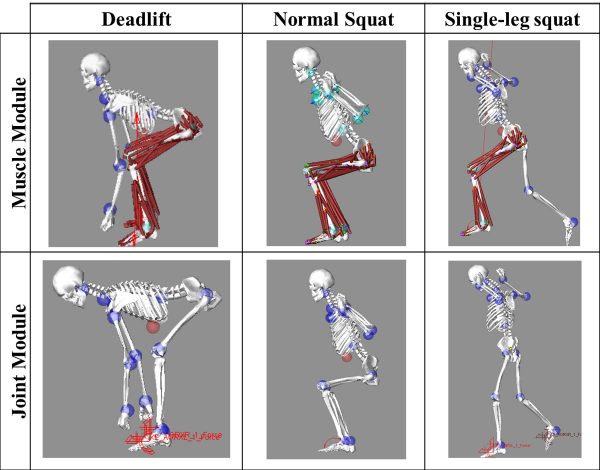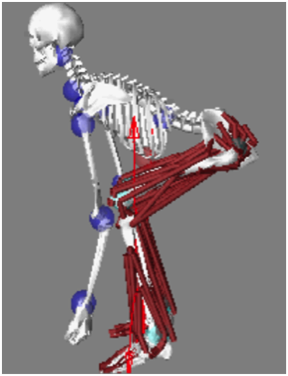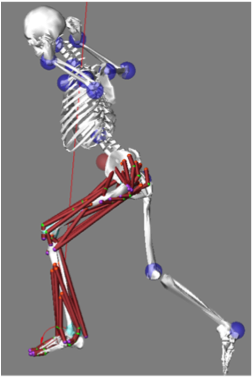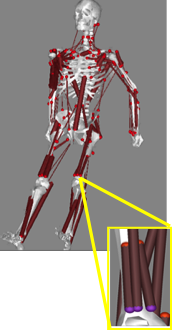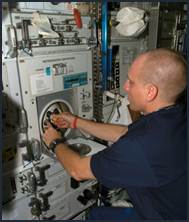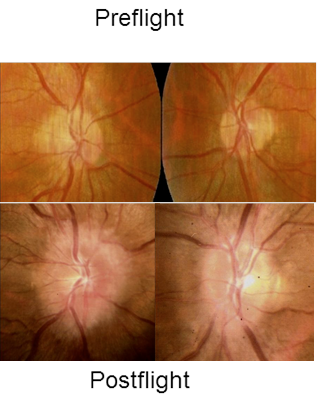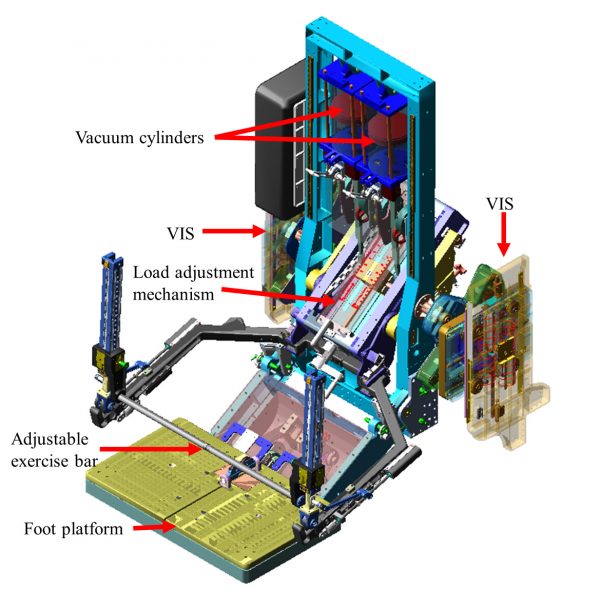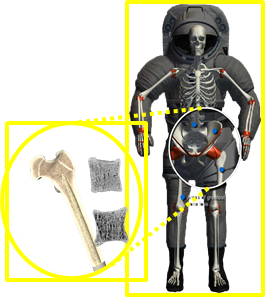Musculoskeletal
The Challenge
There exists very limited data for determining the effectiveness of human health and performance countermeasures intended to preserve astronaut health during long duration space exploration missions. Exercise countermeasures used in the Space Shuttle Program and on the International Space Station do not eliminate bone loss or muscle deconditioning. Without an effective countermeasure, astronauts lose bone density at a rate of 1-2% a month, which may lead to early onset osteoporosis and place the astronaut at greater risk of fracture after returning to the earth’s gravitational field.
The Research
The Computational Modeling Project developed computational simulations of humans using several exercise devices that might be used during an exploration mission. These simulations include both the device and the human, thus predicting the loading on both bone and muscle as a result of using the device. This provided both exercise scientists and exercise device developers quantitative comparisons between devices and exercise modalities.
The project also quantified both bone remodeling and demineralization, as well as muscle deconditioning. These models predicted both loss via disuse and preservation via appropriate exercise. These models also used force data produced by the integrated device and human models as input data which can be used to predict the time course of bone and muscle health as a function of exercise regimen during long duration exploration missions. Eliminating those losses was the goal of this work.
The Results
The Computational Modeling Project produced device models of the Advanced Resistive Exercise Device (ARED), which astronauts currently use onboard the space station and is the first exercise device experimentally demonstrated to reduce, but not eliminate, both bone loss and muscle deconditioning. ARED is, unfortunately, unable to fit within the confines of an exploration spacecraft, so the project delivered an integrated model of a human using the Hybrid Ultimate Lift Kit (HULK), a potential next generation exercise device, to perform squat and heel raise exercises. The project also delivered a bone turnover model capable of predicting bone mineral density, a measure of bone health, as a function of whether or not the astronaut exercised during a 180 day mission.
Acronyms
ARED – Advanced Resistive Exercise Device
HULK – Hybrid Ultimate Lift Kit
NASA – National Aeronautics and Space Administration
NASA-STD – NASA Standard
VIS – Vibration Isolation System
Technical Data
Published Articles and Technical Reports
- Evidence Book: Risk of Orthostatic Intolerance During Re-exposure to Gravity
- A Computational Model for Simulating Spaceflight Induced Bone Remodeling
- Integrated Biomechanical Modeling of Lower Body Exercises on the Advanced Resistive Exercise Device (ARED) Using LifeMOD
- Evaluating Daily Load Stimulus Formulae in Relating Bone Response to Exercise
- A mathematical model of oxygen transport in skeletal muscle during hindlimb unloading
- Predicting Bone Mechanical State During Recovery After Long-Duration Skeletal Unloading Using QCT and Finite Element Modeling
- Theoretical Analysis of the Mechanisms of a Gender Differentiation in the Propensity for Orthostatic Intolerance After Spaceflight
- Simulating Bone Loss in Microgravity Using Mathematical Formulations of Bone Remodeling
- Image-based computational fluid dynamics in blood vessel models: toward developing a prognostic tool to assess cardiovascular function changes in prolonged space flights.
- The NASA Digital Astronaut Project
Conference Presentations and Posters
- Adapting NASA-STD-7009 to Assess the Credibility of Biomedical Models and Simulations
- Pathway to Credible Practice Guidelines for Computational Modeling in Healthcare
- The Digital Astronaut Project: Applying Computational Modeling to Preserve the Health of Astronauts
- The Value of Biomedical Simulation Environments to Future Human Space Flight Missions
- Musculoskeletal Modeling Component of the NASA Digital Astronaut Project
- The Graphical Representation of the Digital Astronaut Physiology Backbone
Musculoskeletal Gaps
What is an HRP Gap?
Evidence from medical records, spaceflight operations and research findings provides the basis for identifying the most significant human risks in space exploration, including physiological and performance effects from hazards such as altered gravity, radiation, hostile/closed environments, isolation and distance. Each risk is assigned to an HRP Element (divisions of human research) to identify knowledge gaps, or the critical questions that must be answered, in order to mitigate the risk. These gaps become the focus of research conducted to reduce the likelihood and consequence of risks becoming a reality. To learn more about the Risk Identification and Mitigation process and the tasks developed to reduce those risks for the program please select the links below the for more information.
M7 Efficient Exercise Regimen
M9 Exercise Hardware
M24 Time Course of Changes in Muscle
Osteo 1 Bone Health Standard
Osteo 2 Osteoporosis & Fractures
Videos
In an effort to prevent bone loss and muscle deconditioning normally associated with spaceflight, NASA has been developing and testing exercise devices. While data suggest that the Advanced Resistive Exercise Device (ARED) mitigates these losses on the International Space Station (ISS), ARED is far too large to use in a space vehicle designed for long duration exploration missions. As a result, NASA has been designing and testing compact devices with a goal of developing one that produces the same benefit as ARED. During testing, NASA engineers placed reflective markers on the subject to follow fixed location on the body during exercise. They then processed those images into motion files using the OpenSim software package in conjunction with data on the force produced at the subject’s feet, to quantify the force applied to the muscle and bone in the legs. This video clip is from the OpenSim model.
|
|
Despite advances made in using resistive exercise to preserve bone and muscle in the hip, lumbar spine, and thigh regions, astronauts still experience muscle atrophy in the muscles of their calf. On earth, physical therapists and trainers recommend heel raise exercises to strengthen these muscles. This model of the heel raise exercise should provide NASA exercise physiologists with the data required to better prescribe exercise to protect the strength of these muscles.
|
|
NASA developed an advanced exercise device referred to as the Hybrid Ultimate Load Kit (HULK) that enables the subject to perform squats, lunges, and dead lifts. The HULK device loads the subject via a bar across the shoulders. Due to the nature of the OpenSim environment, and because all the load is borne at the lumbar spine and in the legs, for simplicity the model does not include the subject’s arms.
|
|
Gallery
Cardiovascular Impacts
What are the in-flight alterations in cardiac structure and function?
Evidence from medical records, spaceflight operations and research findings provides the basis for identifying the most significant human risks in space exploration, including physiological and performance effects from hazards such as altered gravity, radiation, hostile/closed environments, isolation and distance. Each risk is assigned to an HRP Element (divisions of human research) to identify knowledge gaps, or the critical questions that must be answered, in order to mitigate the risk. These gaps become the focus of research conducted to reduce the likelihood and consequence of risks becoming a reality. To learn more about the Risk Identification and Mitigation process and the tasks developed to reduce those risks for the program please click on the link below the gap for more information.
Measuring VO2 inflight
What is VO2max in-flight and immediately post-flight?
Evidence from medical records, spaceflight operations and research findings provides the basis for identifying the most significant human risks in space exploration, including physiological and performance effects from hazards such as altered gravity, radiation, hostile/closed environments, isolation and distance. Each risk is assigned to an HRP Element (divisions of human research) to identify knowledge gaps, or the critical questions that must be answered, in order to mitigate the risk. These gaps become the focus of research conducted to reduce the likelihood and consequence of risks becoming a reality. To learn more about the Risk Identification and Mitigation process and the tasks developed to reduce those risks for the program please click on the link below the gap for more information.
Predicting Heart Disease
Can manifestations of sub-clinical or environmentally induced cardiovascular diseases during spaceflight be predicted?
Evidence from medical records, spaceflight operations and research findings provides the basis for identifying the most significant human risks in space exploration, including physiological and performance effects from hazards such as altered gravity, radiation, hostile/closed environments, isolation and distance. Each risk is assigned to an HRP Element (divisions of human research) to identify knowledge gaps, or the critical questions that must be answered, in order to mitigate the risk. These gaps become the focus of research conducted to reduce the likelihood and consequence of risks becoming a reality. To learn more about the Risk Identification and Mitigation process and the tasks developed to reduce those risks for the program please click on the link below the gap for more information.
Outcome of Medical Events
We do not know the quantified health and mission outcomes due to medical events during exploration missions.
Evidence from medical records, spaceflight operations and research findings provides the basis for identifying the most significant human risks in space exploration, including physiological and performance effects from hazards such as altered gravity, radiation, hostile/closed environments, isolation and distance. Each risk is assigned to an HRP Element (divisions of human research) to identify knowledge gaps, or the critical questions that must be answered, in order to mitigate the risk. These gaps become the focus of research conducted to reduce the likelihood and consequence of risks becoming a reality. To learn more about the Risk Identification and Mitigation process and the tasks developed to reduce those risks for the program please click on the link below the gap for more information.
Doctor on Board?
We do not know how the inclusion of a physician crew medical officer quantitatively impacts medical risk during exploration missions.
Evidence from medical records, spaceflight operations and research findings provides the basis for identifying the most significant human risks in space exploration, including physiological and performance effects from hazards such as altered gravity, radiation, hostile/closed environments, isolation and distance. Each risk is assigned to an HRP Element (divisions of human research) to identify knowledge gaps, or the critical questions that must be answered, in order to mitigate the risk. These gaps become the focus of research conducted to reduce the likelihood and consequence of risks becoming a reality. To learn more about the Risk Identification and Mitigation process and the tasks developed to reduce those risks for the program please click on the link below the gap for more information.
Microgravity Countermeasures
How does 1/6-g and 3/8-g influence countermeasures?
Evidence from medical records, spaceflight operations and research findings provides the basis for identifying the most significant human risks in space exploration, including physiological and performance effects from hazards such as altered gravity, radiation, hostile/closed environments, isolation and distance. Each risk is assigned to an HRP Element (divisions of human research) to identify knowledge gaps, or the critical questions that must be answered, in order to mitigate the risk. These gaps become the focus of research conducted to reduce the likelihood and consequence of risks becoming a reality. To learn more about the Risk Identification and Mitigation process and the tasks developed to reduce those risks for the program please click on the link below the gap for more information.
Efficient Exercise Regimen
Develop the most efficient and effective exercise program for the maintenance of muscle function.
Evidence from medical records, spaceflight operations and research findings provides the basis for identifying the most significant human risks in space exploration, including physiological and performance effects from hazards such as altered gravity, radiation, hostile/closed environments, isolation and distance. Each risk is assigned to an HRP Element (divisions of human research) to identify knowledge gaps, or the critical questions that must be answered, in order to mitigate the risk. These gaps become the focus of research conducted to reduce the likelihood and consequence of risks becoming a reality. To learn more about the Risk Identification and Mitigation process and the tasks developed to reduce those risks for the program please click on the link below the gap for more information.
Minimum Exercise Needed?
What is the minimum exercise regimen needed to maintain fitness levels for tasks?
Evidence from medical records, spaceflight operations and research findings provides the basis for identifying the most significant human risks in space exploration, including physiological and performance effects from hazards such as altered gravity, radiation, hostile/closed environments, isolation and distance. Each risk is assigned to an HRP Element (divisions of human research) to identify knowledge gaps, or the critical questions that must be answered, in order to mitigate the risk. These gaps become the focus of research conducted to reduce the likelihood and consequence of risks becoming a reality. To learn more about the Risk Identification and Mitigation process and the tasks developed to reduce those risks for the program please click on the link below the gap for more information.
Exercise Hardware
Identify and validate exploration countermeasure hardware for the maintenance of muscle function.
Evidence from medical records, spaceflight operations and research findings provides the basis for identifying the most significant human risks in space exploration, including physiological and performance effects from hazards such as altered gravity, radiation, hostile/closed environments, isolation and distance. Each risk is assigned to an HRP Element (divisions of human research) to identify knowledge gaps, or the critical questions that must be answered, in order to mitigate the risk. These gaps become the focus of research conducted to reduce the likelihood and consequence of risks becoming a reality. To learn more about the Risk Identification and Mitigation process and the tasks developed to reduce those risks for the program please click on the link below the gap for more information.
Time Course of Changes in Muscle
Characterize the time course of changes in muscle protein turnover, muscle mass, and function during long duration space flight.
Evidence from medical records, spaceflight operations and research findings provides the basis for identifying the most significant human risks in space exploration, including physiological and performance effects from hazards such as altered gravity, radiation, hostile/closed environments, isolation and distance. Each risk is assigned to an HRP Element (divisions of human research) to identify knowledge gaps, or the critical questions that must be answered, in order to mitigate the risk. These gaps become the focus of research conducted to reduce the likelihood and consequence of risks becoming a reality. To learn more about the Risk Identification and Mitigation process and the tasks developed to reduce those risks for the program please click on the link below the gap for more information.
Bone Health Standard
A new acceptable bone health standard using an expanded surrogate for bone health needs to be defined for the flight environment.
Evidence from medical records, spaceflight operations and research findings provides the basis for identifying the most significant human risks in space exploration, including physiological and performance effects from hazards such as altered gravity, radiation, hostile/closed environments, isolation and distance. Each risk is assigned to an HRP Element (divisions of human research) to identify knowledge gaps, or the critical questions that must be answered, in order to mitigate the risk. These gaps become the focus of research conducted to reduce the likelihood and consequence of risks becoming a reality. To learn more about the Risk Identification and Mitigation process and the tasks developed to reduce those risks for the program please click on the link below the gap for more information.
Osteoporosis & Fractures
What is the incidence & prevalence of early onset osteoporosis or fragility fractures due to exposure to spaceflight.
Evidence from medical records, spaceflight operations and research findings provides the basis for identifying the most significant human risks in space exploration, including physiological and performance effects from hazards such as altered gravity, radiation, hostile/closed environments, isolation and distance. Each risk is assigned to an HRP Element (divisions of human research) to identify knowledge gaps, or the critical questions that must be answered, in order to mitigate the risk. These gaps become the focus of research conducted to reduce the likelihood and consequence of risks becoming a reality. To learn more about the Risk Identification and Mitigation process and the tasks developed to reduce those risks for the program please click on the link below the gap for more information.
Ocular changes
We do not know the etiological mechanisms and contributing risk factors for ocular structural and functional changes seen in-flight and post-flight.
Evidence from medical records, spaceflight operations and research findings provides the basis for identifying the most significant human risks in space exploration, including physiological and performance effects from hazards such as altered gravity, radiation, hostile/closed environments, isolation and distance. Each risk is assigned to an HRP Element (divisions of human research) to identify knowledge gaps, or the critical questions that must be answered, in order to mitigate the risk. These gaps become the focus of research conducted to reduce the likelihood and consequence of risks becoming a reality. To learn more about the Risk Identification and Mitigation process and the tasks developed to reduce those risks for the program please click on the link below the gap for more information.
Medical Event Risk Metrics
We need to characterize the medical conditions that can occur during exploration missions and their relevant associated end states, management options, and the capabilities necessary to manage them (what can happen, how bad could it be, what can we do to improve it?).
Evidence from medical records, spaceflight operations and research findings provides the basis for identifying the most significant human risks in space exploration, including physiological and performance effects from hazards such as altered gravity, radiation, hostile/closed environments, isolation and distance. Each risk is assigned to an HRP Element (divisions of human research) to identify knowledge gaps, or the critical questions that must be answered, in order to mitigate the risk. These gaps become the focus of research conducted to reduce the likelihood and consequence of risks becoming a reality. To learn more about the Risk Identification and Mitigation process and the tasks developed to reduce those risks for the program please click on the link below the gap for more information.
Integrated Exploration Medical System Models
We need to develop integrated exploration medical system models for the Moon and Mars.
Evidence from medical records, spaceflight operations and research findings provides the basis for identifying the most significant human risks in space exploration, including physiological and performance effects from hazards such as altered gravity, radiation, hostile/closed environments, isolation and distance. Each risk is assigned to an HRP Element (divisions of human research) to identify knowledge gaps, or the critical questions that must be answered, in order to mitigate the risk. These gaps become the focus of research conducted to reduce the likelihood and consequence of risks becoming a reality. To learn more about the Risk Identification and Mitigation process and the tasks developed to reduce those risks for the program please click on the link below the gap for more information.
Cardiovascular Impacts from Weightlessness
Determine whether long-duration weightlessness induces cardiovascular structural and functional changes and/or oxidative stress & damage (OSaD)/inflammation, that can contribute to development of disease.
Evidence from medical records, spaceflight operations and research findings provides the basis for identifying the most significant human risks in space exploration, including physiological and performance effects from hazards such as altered gravity, radiation, hostile/closed environments, isolation and distance. Each risk is assigned to an HRP Element (divisions of human research) to identify knowledge gaps, or the critical questions that must be answered, in order to mitigate the risk. These gaps become the focus of research conducted to reduce the likelihood and consequence of risks becoming a reality. To learn more about the Risk Identification and Mitigation process and the tasks developed to reduce those risks for the program please click on the link below the gap for more information.
Fluid Intake
Is it necessary to increase crew fluid intake and, if possible, to what extent will it mitigate stone formation?
Evidence from medical records, spaceflight operations and research findings provides the basis for identifying the most significant human risks in space exploration, including physiological and performance effects from hazards such as altered gravity, radiation, hostile/closed environments, isolation and distance. Each risk is assigned to an HRP Element (divisions of human research) to identify knowledge gaps, or the critical questions that must be answered, in order to mitigate the risk. These gaps become the focus of research conducted to reduce the likelihood and consequence of risks becoming a reality. To learn more about the Risk Identification and Mitigation process and the tasks developed to reduce those risks for the program please click on the link below the gap for more information.
Frequency of formation
What is the frequency of post-flight stone formation; the incidence and types of stones; and the time course of stone formation? How does stone formation correlate with food intake and hydration status?
Evidence from medical records, spaceflight operations and research findings provides the basis for identifying the most significant human risks in space exploration, including physiological and performance effects from hazards such as altered gravity, radiation, hostile/closed environments, isolation and distance. Each risk is assigned to an HRP Element (divisions of human research) to identify knowledge gaps, or the critical questions that must be answered, in order to mitigate the risk. These gaps become the focus of research conducted to reduce the likelihood and consequence of risks becoming a reality. To learn more about the Risk Identification and Mitigation process and the tasks developed to reduce those risks for the program please click on the link below the gap for more information.

